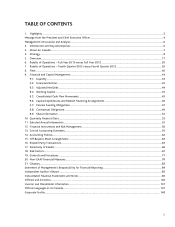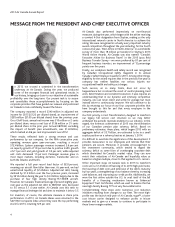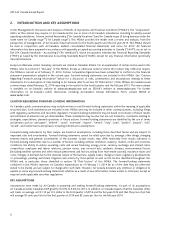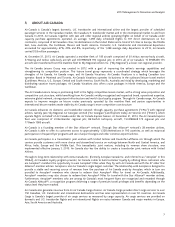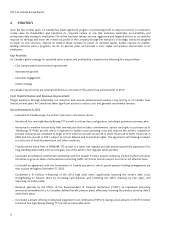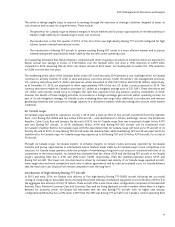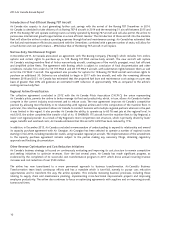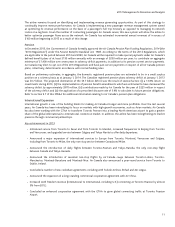Air Canada 2013 Annual Report Download - page 13
Download and view the complete annual report
Please find page 13 of the 2013 Air Canada annual report below. You can navigate through the pages in the report by either clicking on the pages listed below, or by using the keyword search tool below to find specific information within the annual report.2013 Management’s Discussion and Analysis
13
In addition, in 2014, Air Canada will continue to bolster its Asia-Pacific presence. Beginning on July 1, 2014, Air Canada will
operate daily flights between Toronto-Pearson and Tokyo-Haneda (Tokyo International Airport) using the Boeing 787
Dreamliner. The new year-round service will be both the only non-stop flight between Canada and Tokyo-Haneda, located less
than 30 minutes from downtown Tokyo, and the first daytime flight to Tokyo-Haneda from North America. This will be the
first deployment of Air Canada's Dreamliner aircraft in the Asian market and will feature the airline's new seating and cabin
amenities. The new route will complement Air Canada's existing service to Tokyo Narita International Airport from Toronto,
Calgary and Vancouver, which Air Canada will continue to offer. Both Japanese airports offer a wealth of onward domestic and
international connections through All Nippon Airways and other Star Alliance® partners.
Air Canada rouge’s lower cost structure enables Air Canada to compete on a more cost effective basis in the leisure market.
While the Airbus A319 aircraft operated by Air Canada rouge are being used to provide service to leisure destinations
previously operated by Air Canada mainline, the Boeing 767-300ER aircraft operated by Air Canada rouge are being used to
provide service to certain European and high volume North American leisure destinations previously operated by the mainline
fleet as well as to new leisure destinations in Europe. As part of the 2014 summer schedule, Air Canada rouge plans to launch
seasonal non-stop flights to Barcelona, Dublin, Lisbon, Manchester, Nice and Rome and to continue to operate its summer
routes to Athens, Edinburgh and Venice. In addition, routes previously operated by Air Canada from Toronto and Montreal to
Cuba, Dominican Republic, Bahamas, Barbados, Haiti, Cancun and Tampa, Florida, will be converted beginning in the spring of
2014 to Air Canada rouge service, for a total of 44 routes serving 28 vacation destinations, including Air Canada rouge’s new
European destinations.
In 2014, Air Canada plans to continue to grow global international to international transit traffic via Canada through its world-
class hub in Toronto and its strong international gateways in Montreal, Vancouver and Calgary. The airline believes that it has
the potential to grow international to international transit traffic, particularly from the U.S., over the coming years given its
award-winning products and services, geographically well-positioned hubs in Canada, extensive network and other
competitive advantages. Based on an airline industry benchmark indicating the percentage of traffic from the U.S. to Europe
and Asia by non-U.S. carriers, Air Canada’s share is only 0.3%. Air Canada has determined that its fair share of this
international to international transit traffic should be 1.5% and has estimated that an increase to this level would drive
incremental annual revenues of more than $400 million.
Over the last several years, Air Canada has been working closely with the GTAA to transform Toronto Pearson into a leading
North American airport in order to gain a greater share of the global international to international connection market. In this
regard, the GTAA and Air Canada recently concluded an enhanced commercial relationship which is designed to deliver
continued improvements to customer service and which will place Air Canada in a better position to capture a larger share of
growing international traffic flows on a more cost effective basis. Toronto Pearson has a strategic advantage due to its
proximity to densely populated major markets in the U.S. and is also a destination for a large number of business and leisure
travelers. Moreover, Air Canada and its Star Alliance® partners’ operations are consolidated in one terminal, and Toronto
Pearson has efficient in-transit facilities which allow passengers and their bags to move seamlessly between Canada and U.S.
Customs and Immigration.
The further development of commercial alliances with major international carriers continues to be an important aspect of
Air Canada’s business strategy. These commercial arrangements provide Air Canada with an effective way of leveraging
expansion and broadening its network appeal. Air Canada is extending its global reach through its membership in Star
Alliance® and through its participation in a transatlantic revenue sharing joint venture with United Airlines and Deutsche
Lufthansa AG, referred to as A++. By coordinating pricing, scheduling and sales, Air Canada is better able to serve customers
by offering more travel options, while reducing travel times. Air Canada is also achieving greater critical mass and network
scope through numerous codeshare and interline agreements. For example, to complement Air Canada’s new service to
Istanbul, in 2013, Air Canada and Turkish Airlines concluded a reciprocal code-sharing agreement which ensures seamless
connections on a single itinerary for customers travelling beyond Istanbul, throughout Turkey and to points in Central Asia,
Africa and the Middle East. Air Canada also recently announced the expansion of a long-standing commercial cooperation
agreement with Air China which will enable seamless bookings and connections for customers and their bags via the
carriers' Vancouver, Toronto and Beijing hubs to six new China destinations and six new destinations in Canada.


